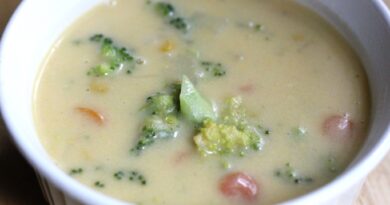Clam Chowder Recipe With Special Tips
Table of Contents
What is Clam Chowder?
Clam chowder is a thick and creamy soup filled with the flavors and textures of clams, bacon, and potatoes. As a beginning, serve with crusty bread. Although clam chowder is often cooked with clams and potatoes, other types of frozen seafood can be used. Most parts of the world have their own take on this meal, and each of them is excellent in its own way.
About Clam Chowder Recipe
Almost each bite has clams in it, which is fantastic because what you receive at restaurants has very few clams and vegetables and a lot of cream. I feel that making my own clam chowder is far more fun than eating out. It’s a dish that’s much simpler to create than you would believe. Prepare this cup of comfort the next time you want something to warm you up on a cold night. This dish has a rich taste that rivals Panera’s clam chowder. It includes basic ingredients and requires little preparation.
Raw Materials Required
4 slices bacon, chopped 2 medium Yukon gold potatoes, diced small (about 1 lb.)
2 tbsp. unsalted butter 1 bay leaf, optional
1 large yellow onion, chopped 1 tsp. kosher salt
3 stalks celery, chopped 1 tsp. pepper
2 garlic cloves, finely chopped Two 6.5 oz. cans chopped clams
1/3 cup all-purpose flour Half cup heavy cream
Two 8 oz. bottles clam juice 2 tbsp. chopped fresh parsley or chives
Half cup milks Oyster crackers, for serving
Procedure
Serving Size 4 Total Time 45 Minutes
- In a Dutch oven or large saucepan, fry the bacon over medium heat, turning periodically, until crisp, 5 to 7 minutes. Transfer the bacon to a plate lined with paper towels and set aside the bacon excess liquid in the pan.
- To the bacon liquid, add the butter, then the onion and celery. Cook, stirring occasionally, for 4 minutes, or until slightly softened. Cook for 1 minute more after adding the garlic. Sprinkle the flour over the veggies and simmer for 2 minutes, stirring regularly. Whisk in the clam broth and milk gradually until creamy. Return to a simmer, stirring regularly and scraping the bottom and corners of the pan to prevent the flour from sticking.
- Return to a simmer, stirring regularly, with the potatoes, bay leaf, salt, and pepper. Turn the heat down to medium-low after the sauce has begun to simmer. Cook, partially covered, for about 15 minutes, or until the potatoes are little soft.
- Combine the clams and their juices in their cans. Return to a simmer and cook, partially covered, for 10 minutes, or until little thickened. Now add the cream. Heat the cream until it is barely warmed through. Take the pan off the heat. Take out the bay leaf.
- To serve, sprinkle with fresh parsley or chives and the remaining cooked bacon. With oyster crackers, serve.
Nutritional Facts
| Nutritional Facts (Per Serving) | |
| 260 | CALORIES |
| 6g | FAT |
| 45g | CARBS |
| 13g | PROTEIN |
Some Quick & Significant Tips
- Don’t leave out the bacon. That small bit of bacon gives much more flavour, both in the soup and as a garnish, and makes every taste irresistibly delicious.
- Consider leaving out the bacon and replace the chicken stock with veggie broth or your preferred substitution to make this clam chowder vegetarian.
- As it cools, the soup will thicken even more. If necessary, thicken it up with additional milk or chicken broth and bring it back to a boil.
- Depending on the thickness of the potatoes, the cooking time could need to be modified.
Where did clam chowder come from?
The term “chowder” was initially used to describe a soup in the late 17th century. This traditional chowder was cooked with fish, onion, breadcrumbs, and salt pork before being thickened with cracker meal or flour. Potatoes were not added to the mix until many years later. Clam chowder’s roots are a little fuzzy, although most think it was invented by French settlers who arrived in North America in the 17th century. These settlers were seeking for a method to use up the plentiful clams they discovered in the area waterways, so they began preparing a soup or stew with them. Other European adventurers who settled in New England were quick to pick up on this cuisine, and clam chowder was soon available across the region. The dish changed through time and became popular all across the world.
How many different varieties are there?
The two most common styles are New England-style and Manhattan-style, which are defined by their white and red hues, respectively. However, there are several additional different types from all across the East Coast, as well as those from the West Coast.
New England-style: New England chowder, sometimes known as “Boston-style” clam chowder, is milk or cream-based, making it substantially thicker than other regional variations. It’s frequently cooked with milk, butter, potatoes, pork, onion, and clams, and served with oyster crackers.
Manhattan-style: Clams, bacon, veggies, and potatoes are cooked in a flavorful tomato broth in this Manhattan clam chowder. A substantial soup that’s simple to cook and works well as an appetizer or main entrée.
New Jersey has its own variation, which is closer to Manhattan clam chowder. It’s created with tomatoes, asparagus cream, light cream, and bacon. There’s also Old Bay seasoning, parsley, and celery powder in there. Moving south to Florida, Minorcan clam chowder is one of the city’s hallmark meals. This one is tomato-based, comparable to Manhattan-style. However, one extremely distinct ingredient distinguishes Florida’s version: datil pepper. The pepper, which ranges in hue from green to yellowish orange, is native to Cuba and was introduced to Florida hundreds of years ago. It’s defined as sweet, tangy, and spicy, which gives the soup its distinct flavour. Minorcan refers to Florida settlers from the Spanish island of Minorca, who made the substantial soup using local ingredients in a Mediterranean manner.
Thank you For Visiting Our Website (Informal House)




